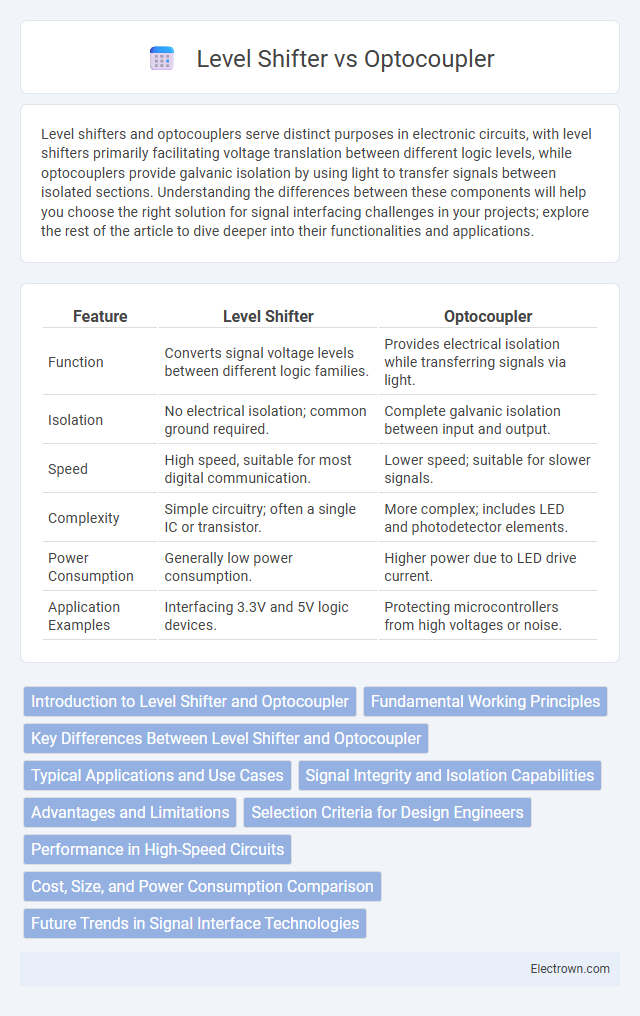Level shifters and optocouplers serve distinct purposes in electronic circuits, with level shifters primarily facilitating voltage translation between different logic levels, while optocouplers provide galvanic isolation by using light to transfer signals between isolated sections. Understanding the differences between these components will help you choose the right solution for signal interfacing challenges in your projects; explore the rest of the article to dive deeper into their functionalities and applications.
Table of Comparison
| Feature | Level Shifter | Optocoupler |
|---|---|---|
| Function | Converts signal voltage levels between different logic families. | Provides electrical isolation while transferring signals via light. |
| Isolation | No electrical isolation; common ground required. | Complete galvanic isolation between input and output. |
| Speed | High speed, suitable for most digital communication. | Lower speed; suitable for slower signals. |
| Complexity | Simple circuitry; often a single IC or transistor. | More complex; includes LED and photodetector elements. |
| Power Consumption | Generally low power consumption. | Higher power due to LED drive current. |
| Application Examples | Interfacing 3.3V and 5V logic devices. | Protecting microcontrollers from high voltages or noise. |
Introduction to Level Shifter and Optocoupler
Level shifters are essential electronic components designed to translate voltage levels between different parts of a circuit, ensuring compatibility and preventing damage to sensitive devices. Optocouplers, also known as optoisolators, provide electrical isolation between input and output by using light to transfer signals, protecting your system from voltage spikes and noise. Both components serve critical roles in signal interfacing but differ significantly in isolation and voltage shifting capabilities.
Fundamental Working Principles
Level shifters operate by translating voltage levels between different logic families or voltage domains using transistors or MOSFETs, ensuring signal compatibility without affecting data integrity. Optocouplers achieve electrical isolation by transferring signals through an LED and a photodetector, converting electrical signals into light and back to prevent ground loops and noise interference. Both devices serve distinct purposes in interfacing circuits, with level shifters focusing on voltage compatibility and optocouplers emphasizing galvanic isolation.
Key Differences Between Level Shifter and Optocoupler
Level shifters and optocouplers serve distinct roles in electronic circuits: level shifters adjust voltage signals between different logic levels, ensuring compatibility between components with varying voltage standards, while optocouplers provide galvanic isolation by transferring signals via light, protecting sensitive parts from high voltages and noise. Key differences include their isolation capabilities--optocouplers offer electrical isolation whereas level shifters do not--and their typical use cases, with level shifters used for signal compatibility and optocouplers for safety and noise immunity. Choosing the right device depends on your need for either voltage translation or isolation in your electronic design.
Typical Applications and Use Cases
Level shifters are commonly used in digital communication interfaces like I2C, SPI, and UART to enable devices with different voltage levels to communicate seamlessly. Optocouplers find typical applications in isolating high-voltage circuits from low-voltage control systems, protecting microcontrollers in industrial automation and power supply monitoring. Your choice depends on whether voltage compatibility or electrical isolation is the primary requirement in your application.
Signal Integrity and Isolation Capabilities
Level shifters provide reliable signal integrity by maintaining proper voltage levels between different logic families, ensuring minimal distortion in high-speed digital signals. Optocouplers offer superior galvanic isolation by using light to transfer signals, effectively protecting circuits from high voltage spikes and ground loops. Your choice depends on whether maintaining signal fidelity or achieving electrical isolation is the primary design requirement.
Advantages and Limitations
Level shifters provide efficient voltage translation between different logic levels with low propagation delay and minimal power consumption, making them ideal for high-speed digital circuits. Optocouplers offer superior electrical isolation and noise immunity, which protects sensitive components in environments with high voltage spikes or interference but suffer from slower response times and higher power usage. The choice depends on whether isolation or signal speed and power efficiency are the primary design priorities.
Selection Criteria for Design Engineers
Design engineers prioritize voltage compatibility, signal speed, and isolation requirements when selecting between level shifters and optocouplers. Level shifters excel in voltage translation with minimal delay, ideal for high-speed digital interfaces, while optocouplers offer galvanic isolation to protect sensitive circuits from voltage spikes and noise. Your choice depends on whether isolation or signal integrity and speed are the primary concerns in your application.
Performance in High-Speed Circuits
Level shifters provide faster signal translation in high-speed circuits due to their direct electrical connection and low propagation delay, making them ideal for timing-critical applications. Optocouplers introduce isolation through optical signaling but generally exhibit slower response times and higher propagation delays, which can limit their use in high-frequency environments. For your design requiring rapid data transfer and minimal latency, level shifters offer superior performance compared to optocouplers.
Cost, Size, and Power Consumption Comparison
Level shifters offer a lower cost solution compared to optocouplers, primarily due to simpler semiconductor components and fewer auxiliary parts. They occupy less PCB space as level shifters are typically integrated circuits, whereas optocouplers require additional optoelectronic elements, increasing size. In terms of power consumption, level shifters are more energy-efficient, leveraging direct electrical signal translation without the light emission and detection processes inherent to optocouplers.
Future Trends in Signal Interface Technologies
Level shifters and optocouplers continue evolving to meet future demands in signal interface technologies, emphasizing higher speed, lower power consumption, and enhanced noise immunity. Emerging trends highlight integrated solutions combining level shifting with isolation for compact designs, supporting IoT and industrial applications requiring reliable communication across diverse voltage domains. Your choice between these technologies will increasingly depend on factors like data rate, isolation requirements, and system complexity as advanced materials and semiconductor processes drive innovation.
Level shifter vs optocoupler Infographic

 electrown.com
electrown.com